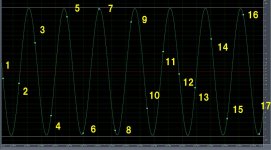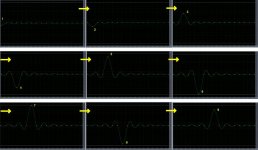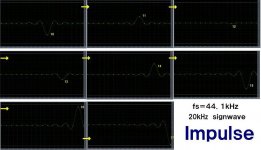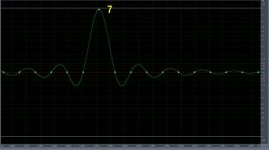Lovers opinion
__1) slow rolloff lovers (They forget interpolation, so they take RINGING not be good)
__2) sharp rolloff lovers (They know interpolation, so they understand RINGING to be needed for good interpolation)
__3) analogue LP's fans (They forget why needs LPF when A/D & D/A conversion, and they are confusing RINGING with distortion)
KEYWORD is
_____________ IMPULSE _____________
__sample_____ OVERLAP _____sample__
__44.1kHz_____ 44.1kHz _____44.1kHz__
__1) slow rolloff lovers (They forget interpolation, so they take RINGING not be good)
__2) sharp rolloff lovers (They know interpolation, so they understand RINGING to be needed for good interpolation)
__3) analogue LP's fans (They forget why needs LPF when A/D & D/A conversion, and they are confusing RINGING with distortion)
KEYWORD is
_____________ IMPULSE _____________
__sample_____ OVERLAP _____sample__
__44.1kHz_____ 44.1kHz _____44.1kHz__
Attachments
AUTMATIC
Hello spzzzzktsan,
ALPHA is.....
Automatic
Low-
Passfilter
Harmonic
Adjustment
There are 2 characteristics, when playback TEST CD playback mode is no ringing impulse mode, and when playback Music CD mode is ringing impulse mode, changing automatically.
Therefore, if we playback sine wave, there is not distortion like slow rolloff.
Hello spzzzzktsan,
ALPHA is.....
Automatic
Low-
Passfilter
Harmonic
Adjustment
There are 2 characteristics, when playback TEST CD playback mode is no ringing impulse mode, and when playback Music CD mode is ringing impulse mode, changing automatically.
Therefore, if we playback sine wave, there is not distortion like slow rolloff.
Hi,
thanks Spzzzkkktt and Nagaesan for yours pateience!
I know I am annoiyng expert people here.
( partial consolation :the same could be occours in inverted parts ( maybe!) if we speaking of serious speaker, but!😀 )
Thus, if possible please you teach, I learn! 🙂
Backing in topic ,BTW, I 'm starting believe to understand Tetsuya's point.
He has indirected answered to my questions.
Shannon require .....ringing. If no ringing occour you are distorting the sine at 20Khz. Am I right?
Considering now the 15 years old ALPHA processor ( DA-S1), things IMO are improved than before it.
My stupid question is : how much is distorted this sine 20Khz?
I have some old magazines, but distortion test was performed good IMO , maybe I have to post the graphic?.
"spurious" test: ( - 88 dB at 44KHz!)( 3150Hz tone; 0 dB; 0-100KHz analysis band) for the DA-S1 are showed.
Frequency reponse are flat up to 20 Khz, perfect.
impulsive response is NO-ringing. Perfect.
Can you please give my some datas? Just curious to quantify the order of magnitude of the phenomena of this 20KHz distortion.
After we can speak about human perception, if you are disponible🙄
Thanks,
Paolo
thanks Spzzzkkktt and Nagaesan for yours pateience!

I know I am annoiyng expert people here.
( partial consolation :the same could be occours in inverted parts ( maybe!) if we speaking of serious speaker, but!😀 )
Thus, if possible please you teach, I learn! 🙂
Backing in topic ,BTW, I 'm starting believe to understand Tetsuya's point.
He has indirected answered to my questions.
Shannon require .....ringing. If no ringing occour you are distorting the sine at 20Khz. Am I right?
Considering now the 15 years old ALPHA processor ( DA-S1), things IMO are improved than before it.
My stupid question is : how much is distorted this sine 20Khz?
I have some old magazines, but distortion test was performed good IMO , maybe I have to post the graphic?.
"spurious" test: ( - 88 dB at 44KHz!)( 3150Hz tone; 0 dB; 0-100KHz analysis band) for the DA-S1 are showed.
Frequency reponse are flat up to 20 Khz, perfect.
impulsive response is NO-ringing. Perfect.
Can you please give my some datas? Just curious to quantify the order of magnitude of the phenomena of this 20KHz distortion.
After we can speak about human perception, if you are disponible🙄
Thanks,
Paolo
at 16bit 44hz / CD format, you have only 2 samples to represent a 20khz sinewave (2 samples / sinewave cycle), the problem stems from this root cause.
So this is a highly biased test, cause 8x interpolation attempts to guess and adds many more samples, and if its linear phase and steep, then it adds them in a correct way (again this is all for continous sinewave - nowhere in music!!) .
This is the same biased test as the NOS 000-111 squarewave (again , nowwhere in music!! 000-111 is not bandlimited).
The deception around digital filters (or their absence) is insane, and ther is a boatload of arguing going on everywhere.
So this is a highly biased test, cause 8x interpolation attempts to guess and adds many more samples, and if its linear phase and steep, then it adds them in a correct way (again this is all for continous sinewave - nowhere in music!!) .
This is the same biased test as the NOS 000-111 squarewave (again , nowwhere in music!! 000-111 is not bandlimited).
The deception around digital filters (or their absence) is insane, and ther is a boatload of arguing going on everywhere.
Lets disregard phase and out of band "crap" .
Slow roll-off @ 20khz :
AM modulation on 20khz source, looks rather like a "musical waveform" instead of measurement data
AM modulation degree is lot smaller @ 15khz , actually its insignificant.
AM modulation non-existant @ 10khz sinewave test.
Should I care about AM modulation at 20khz?
Slow roll-off @ 20khz :
An externally hosted image should be here but it was not working when we last tested it.
AM modulation on 20khz source, looks rather like a "musical waveform" instead of measurement data
AM modulation degree is lot smaller @ 15khz , actually its insignificant.
AM modulation non-existant @ 10khz sinewave test.
Should I care about AM modulation at 20khz?
Filter Coeff
Hi tritosine,
Do you know where I can find coefficients for slow and fast roll off filters ? I have not seen any chip manufacturers publish these. It seems to me that there is much debate over filter types but the real problem is that 44.1K is too slow of a sample rate. There will be no perfect solution. I would like to simulate the filter's output with real CD source data (from a WAV file) to compare time domain outputs using different filter types.
Thanks,
rudee.
tritosine said:Lets disregard phase and out of band "crap" .
Slow roll-off @ 20khz :
An externally hosted image should be here but it was not working when we last tested it.
AM modulation on 20khz source, looks rather like a "musical waveform" instead of measurement data
AM modulation degree is lot smaller @ 15khz , actually its insignificant.
AM modulation non-existant @ 10khz sinewave test.
Should I care about AM modulation at 20khz?
Hi tritosine,
Do you know where I can find coefficients for slow and fast roll off filters ? I have not seen any chip manufacturers publish these. It seems to me that there is much debate over filter types but the real problem is that 44.1K is too slow of a sample rate. There will be no perfect solution. I would like to simulate the filter's output with real CD source data (from a WAV file) to compare time domain outputs using different filter types.
Thanks,
rudee.
send me a pm... Btw with chips like DF1704... 1706 , im not sure its good idea to play with slow roll-off toggle option. A good choice however:
Send upconverted 24/96 "whatever filter" from PC, or write 16/96 tracks to dvd!..
Send upconverted 24/96 "whatever filter" from PC, or write 16/96 tracks to dvd!..
tritosine said:send me a pm...
Do you mean part number (PM?) I have a DAC design using a DF1706 that I would like to simulate.
if initial filtering is done "slow -roll off" way, and the 96khz results is oversampled inside df1706 , thats a good way to minimise the integrated DF's impact on sound q. HM now I see it even accepts 192khz, even better, but not really matters. The point is to utilise most resources in the first 2x stage, later 2x stages can be "lesser" in quality, wont really matter.
PM means I sent you an email now 🙂
PM means I sent you an email now 🙂
excuse me guys,
maybe I am ignorant and thus annoing but can please someone explain me where is "wrong"/bad the measurements of DENON DA-S1?
😕
thanks,
Paolo
maybe I am ignorant and thus annoing but can please someone explain me where is "wrong"/bad the measurements of DENON DA-S1?
😕
thanks,
Paolo
well , I never saw / heard such "switch to linear interpolation when transient is detected" DAC... Not even saw measurements...
Of course Tritosine, 🙂
This DAC ( DENON DA-S1) still sound fantastic, like/ more near to analogue LP than 99% of modern digital machines IMO.
IMO Tetsuya understand what I am talking about, at least I hope it ! 😉
Cheers,
Paolo
An externally hosted image should be here but it was not working when we last tested it.
This DAC ( DENON DA-S1) still sound fantastic, like/ more near to analogue LP than 99% of modern digital machines IMO.
IMO Tetsuya understand what I am talking about, at least I hope it ! 😉
Cheers,
Paolo
wow thats extremely good. (wonder where the 2nd order harmonic comes from, summed DA ? )
Was denon the first to use such "transient" filter? I know also Meitner and Wadia did. Im not sure whats wrong either, might be that this method only works with test cd-s and not in real life ? 😀
Was denon the first to use such "transient" filter? I know also Meitner and Wadia did. Im not sure whats wrong either, might be that this method only works with test cd-s and not in real life ? 😀
tritosine said:wow thats extremely good. (wonder where the 2nd order harmonic comes from, summed DA ? )
I don't know, maybe the discrete ZFB output stage?
Was denon the first to use such "transient" filter? I know also Meitner and Wadia did.
[/B]
Meitner ? Really ? I didn't know. wich models? Older I suppose....
Im not sure whats wrong either, might be that this method only works with test cd-s and not in real life ? 😀 [/B]
Interesting: this is the obscure point I am not capable to understand.
Are you saying that it can't work in this manner with CD of music because it is "wrong" / erroneous ie marketing bluff ?
😕
OR are you referring to presumible not capability to recognise it in a double blind test ? Just curious, I would be understand the point

Thanks,
Paolo
I mean it s easy to pick "1" out of 0001000 (test cd)
try that at music with 30-40 track count?
if you look at audio data in time , its not 'that' easy to go & pick transients. Most of the times the transient is already sitting on some low frequency waveform.
I have no idea how they do it... HDCD is OK, such "triggers" can be embedded there.
try that at music with 30-40 track count?
if you look at audio data in time , its not 'that' easy to go & pick transients. Most of the times the transient is already sitting on some low frequency waveform.
I have no idea how they do it... HDCD is OK, such "triggers" can be embedded there.
- Home
- Source & Line
- Digital Line Level
- PCM1704 or newer chips?




